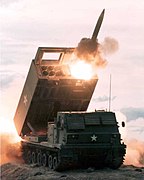Self-propelled artillery
This article needs additional citations for verification. (January 2010) |
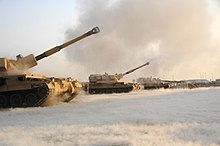
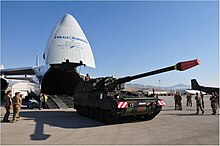
Self-propelled artillery (also called locomotive artillery) is
In the past, self-propelled artillery has included
Modern self-propelled artillery vehicles often mount their main gun in a
The key advantage of self-propelled over towed artillery is that it can be brought into action much faster. Before the towed artillery can be used, it has to stop, unlimber and set up the guns. To move position, the guns must be limbered up again and brought—usually towed—to the new location. By comparison, self-propelled artillery can stop at a chosen location and begin firing almost immediately, then quickly move on to a new position. This shoot-and-scoot ability is very useful in a mobile conflict and particularly on the advance in open battlefields.[1]
Conversely, towed artillery was and remains cheaper to build and maintain. It is also lighter and can be deployed in areas that self-propelled guns cannot reach. Since the
History
Precursors
During the
World War I
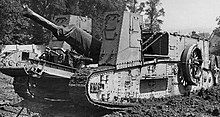
The British
Between the wars
The next major advance can be seen in the Birch gun developed by the British for their motorised warfare experimental brigade (the Experimental Mechanized Force) after the end of the War. This mounted an 18-pounder field gun, capable of both the usual artillery trajectories and high angle anti-aircraft fire, on a Vickers medium tank chassis. It was designed and built for investigations into a general approach to warfare where all arms, infantry and artillery included, would be able to operate over the same terrain as tanks. The Red Army also experimented with truck- and tank-mounted artillery, but produced none in quantity.
World War II

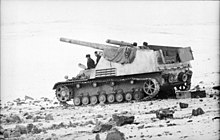
At the outbreak of World War II, virtually all artillery was still being moved around by artillery tractors or horses. While the German
As the war progressed, most nations developed self-propelled artillery. Some early attempts were often no more than a field gun or anti-tank gun mounted on a truck—a technique known in the British Army as carrying
The first battery of self-propelled artillery guns was created when Hauptmann
The Germans also mobilized their anti-tank guns, using light, obsolete or captured tracked vehicles. Examples include the Marder I, using captured French Lorraine 37L tractors, the Marder II, using the Panzer II light tank chassis, and the Marder III, which was based on the Panzer 38(t) Czech chassis. These led to better-protected Assault guns – Sturmgeschütz – with fully enclosed casemates, built on medium tank chassis. In the same way self-propelled anti-tank guns such as the Jagdpanzer IV and Jagdpanther were built. Some designs were based on existing chassis (such as the Brummbär), leftover chassis from cancelled programs (Elefant and Sturer Emil); others were converted from battle-damaged tanks (Sturmtiger). The single most-produced armored fighting vehicle design for Germany in WW II, the Sturmgeschütz III (StuG III) assault gun, in 1936-1937 pioneered the later casemate-style fully enclosed armor that would be used on almost all late-war German self-propelled artillery and Jagdpanzer-format tank destroyers.
The Soviets experimented with truck-and tank-based self-propelled weapons, producing a few Komsomolets tractor-mounted 57-mm
Heavily armoured assault guns were designed to provide direct-fire support to infantry in the face of enemy defenses. Although often similar to tank destroyers, they carried larger caliber guns with weaker anti-armor performance but capable of firing powerful HE projectiles. The German 105mm howitzer-armed StuH 42 based on the StuG III, and the immense 152mm howitzer-armed, Soviet ISU-152, both fully casemated in their design, are examples of this type of self-propelled artillery.
All major nations developed self-propelled artillery that would be able to provide indirect support while keeping pace with advancing armoured formations. These were usually lightly armoured vehicles with an open-topped hull; the American
After the end of
Mortars
Many vehicles have used ancillary
The
Howitzers and guns
Self-propelled artillery remains important in the equipment of many modern armies. It saw a significant role throughout the Cold War era conflicts and in the 1991 Gulf War.
Modern SP artillery is highly computerized with the ability to self survey firing positions using systems such as
These capabilities also increase survivability manyfold as modern SP artillery can displace and avoid
A modern battery of six guns, each firing 43 kg projectiles with a burst firing speed of four rounds per minute, can deliver over a tonne of ordnance per minute for up to four minutes. This is an immense weight of fire, which can be delivered with very high accuracy.
One example of the increased firepower provided by modern mobile howitzers is the latest version of the 155 mm G6 howitzer, the G6-52. It can fire up to six rounds in quick succession that will land nearly simultaneously. This is achieved by firing the shells at different trajectories so that the first round has the longest flight time and the last round the shortest. This is an improvement of the concept of multiple-round simultaneous impact (MRSI), itself an enhancement of the earlier TOT (time on target) concept. The necessary rapid reloading is made possible by an automated ammunition feed system.[citation needed]
Rockets and missiles
Rockets have greater ranges and carry much more complex "shells" than guns, since there is less restriction on size (calibre). A multiple launch rocket system (MLRS) can be used to saturate a large area with sub-munitions.
-
USM270 MLRSlaunching a rocket
See also
- List of artillery
- List of self-propelled howitzers
- Self-propelled anti-aircraft weapon
- G-numbers– US military vehicle and related supply designations
Notes
- ^ a b Bailey, Johnathan B. A., Field Artillery and Firepower, Naval Institute Press, 2004, p. 6.
- ^ Hedberg 1987, pp. 11–13.
- ISBN 978-0-19-566526-0.
- ^ Spielberger 1992, p. 212.
- OCLC 2067459.
- ^ Scafeș, Cornel (2004). "Buletinul Muzeului Național Militar, Nr. 2/2004" [Bulletin of the National Military Museum, No. 2/2004]. Bulletin of the National Military Museum (in Romanian). Bucharest: Total Publishing: 210–237.
Sources
- Hedberg, Jonas (1987). Kungliga artilleriet: Det ridande artilleriet (in Swedish and English). Militärhistor. Förl. ISBN 91-85266-39-6.
- Spielberger, Walter J. (1992) [1989]. Beute-Kraftfahrzeuge und Panzer der Deutschen Wehrmacht [Captured Halftracks and Tanks of the German Military] (in German). Stuttgart: Motorbuch Verlag. ISBN 3-613-01255-3.


